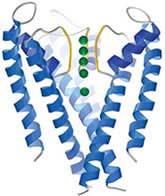Pores for thought

Hole story: channels like this underlie all our movements and thoughts. <br>© Nature/Morais-Cabral et al.
Dazzling snapshots show how ions power nerve signals round the body.
“Potassium channels underlie all our movements and thoughts,” says Rod MacKinnon of Rockefeller University in New York. His team has now unravelled the molecular mechanics of these minute protein pores. Some say the work merits a Nobel Prize.
Potassium (K+) channels power the transmission of nerve signals through the body and the brain by ushering K+ ions in and out of our cells. MacKinnon and his colleagues have taken high-resolution snapshots of the channels in action, revealing how, and how fast, individual K+ ions pass through1,2. It’s a remarkable feat – the K+ channel’s aperture is more than a hundred thousand times thinner than a sheet of paper, at under six Angstroms wide.
The role of K+ channels in nerves has made them “poster children”, but they are important throughout biology, says Christopher Miller, who studies ion channels at Brandeis University in Waltham, Massachusetts. They are present in the lowliest of amoebae and in the cells of the most complex brains.
The latest images of the K+ channel protein are “dazzling”, says Miller. They reveal how cells exploit the positive charge of K+ ions to produce the voltage that powers nerve signals.
For MacKinnon, seeing nature’s economy of design in the finest detail is just as fascinating: “It’s beautiful in how simple it is,” he says.
Channel hopping
Using a technique called X-ray crystallography to image different concentrations of K+ ions in K+ channels, MacKinnon’s team has shown the precise route that the ions take. “It’s almost like you see the ions going through the channel,” says MacKinnon.
The team has found that K+ ions can occupy one of seven positions, five of which only admit K+ ions. The ions hop through the pore, skipping a position at a time as more ions push them through from behind.
Measuring electrical fluctuations across the channel, McKinnon’s team calculate how much energy the K+ ions need to hop from position to position. The channel turns out to be so well tuned to K+ ions that they need almost no energy to pass through, thereby excluding other ions.
“This explains how [the channels] can be so fast yet so selective at the same time,” says Miller. How the channels shuttle only K+ ions faster than a speeding nerve impulse had baffled biologists for decades.
Hole new world
In 1999 MacKinnon received the Lasker Award in basic medical research for revealing the detailed structure of the K+ channel>3. He is now widely tipped as a future recipient of the Noble Prize. The latest work only strengthens that prediction, says Miller: “This is the kind of work that opens up a whole new world.”
Its MacKinnon’s systematic approach to deciphering how the K+ channel works, as well as the channel’s scientific significance, that warrants the ultimate scientific prize, says Fred Sigworth, a molecular physiologist at Yale University School of Medicine in New Haven, Connecticut. “These latest images are only the end of a string of wonderful discoveries by Mackinnon,” he says. “We’re talking about a body of work starting in the 1990s.”
It’s always nice to be recognized, admits MacKinnon, but a possible Nobel Prize does not motivate his research. “I am having so much fun doing the science,” he says. “Nothing can come close to the satisfaction that gives me.”
In fact, having reached “a very deep level of understanding” of K+ channels, MacKinnon now intends to move on to examine how cells open and close their ion channels.
References
- Morais-Cabral, J. H., Zhou, Y. & MacKinnon, R. Energetic optimisation of ion conduction rate by the K+ selectivity filter. Nature, 414, 37 – 42, (2001).
- Zhou, Y., Morais-Cabral, J. H., Kaufman, A. & MacKinnon, R. Chemistry of ion hydration and coordination revealed by a K+ channel-Fab complex at 2.0 A resolution. Nature, 414, 43 – 48, (2001).
- Doyle, D. A. et al. The structure of the potassium channel: molecular basis of K+ conduction and selectivity. Science, 280, 69 – 77, (1998).
Media Contact
All latest news from the category: Life Sciences and Chemistry
Articles and reports from the Life Sciences and chemistry area deal with applied and basic research into modern biology, chemistry and human medicine.
Valuable information can be found on a range of life sciences fields including bacteriology, biochemistry, bionics, bioinformatics, biophysics, biotechnology, genetics, geobotany, human biology, marine biology, microbiology, molecular biology, cellular biology, zoology, bioinorganic chemistry, microchemistry and environmental chemistry.
Newest articles

Why getting in touch with our ‘gerbil brain’ could help machines listen better
Macquarie University researchers have debunked a 75-year-old theory about how humans determine where sounds are coming from, and it could unlock the secret to creating a next generation of more…

Attosecond core-level spectroscopy reveals real-time molecular dynamics
Chemical reactions are complex mechanisms. Many different dynamical processes are involved, affecting both the electrons and the nucleus of the present atoms. Very often the strongly coupled electron and nuclear…

Free-forming organelles help plants adapt to climate change
Scientists uncover how plants “see” shades of light, temperature. Plants’ ability to sense light and temperature, and their ability to adapt to climate change, hinges on free-forming structures in their…





















